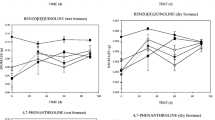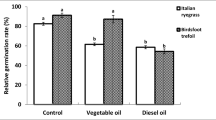Abstract
Pollution of soil by petroleum hydrocarbons is a serious environmental problem world-wide. Although total concentration of contaminants in soil and/or water is used for regulatory review, it also is beneficial to assess the potential for ecosystem impact through a series of bioassays. One commonly used bioassay is seed germination. In this test, seeds are placed in contaminated material, and seedlings enumerated after a specified incubation period. However, different plant species produce variability in response. In the research project reported here, lettuce (Lactuca sativa L.), millet (Panicum miliaceum), radish (Raphanus L.), red clover (Trifolium pratense L.), and wheat (Triticum aestivum) were tested for sensitivity to petroleum-contaminated soil in germination tests. While most plants appeared to show some sensitivity to the pollutant, only lettuce had a statistically significant difference in response to contaminated and uncontaminated soil. These results confirm that Latuca sativa L is the optimal plant choice for standard germination toxicity tests with petroleum-impacted soil.
Similar content being viewed by others
References
Adam, G. and Duncan, H.: 2002, ‘Influence of diesel fuel on seed germination’, Environ. Poll. 120, 363–370.
Boutin, C., Elmegaard, N. and Kjeer, C.: 2004, ‘Toxicity testing of fifteen non-crop plant species with six herbicides in a greenhouse experiment: Implications for risk assessment’, Ecotox. 13, 349–369.
Chang, A. C., Granato, T. C. and Page, A. L.: 1992, ‘A methodology for establishing phytotoxicity criteria for chromium, copper, nickel, and zinc in agricultural land application of municipal sewage sludges’, J. Environ. Qual. 21, 521–536.
Dorn, P. B., Salanitro, J. P. and Wisniewski, H. L.: 1998, ‘Assessment of the acute toxicity of crude oils in soils using earthworms, microtox, and plants’, Chemosphere 37, 845–860.
Fletcher, J., Muhitch, M. J., Vann, D. R., McFarlane, J. C. and Beneathife, F. E.: 1985, ‘Phytotox database evaluation of surrogate plant species recommended by the U.S. EPA and the Organization for Economic Cooperation and Development’, Environ. Tox. Chem. 4, 523–532.
Frische, T.: 2003, ‘Ecotoxicological evaluation of in situ bioremediation of soils contaminated by the explosive 2,4,6-trinitrotoluene (TNT)’, Environ. Poll. 121, 103–113.
Gunderson, C. A., Kostuk, J. M., Gibss, M. H., Napolitano, G. E., Wicker, L. F., Richmond, J. E. and Stewart, A. J.: 1997, ‘Multispecies toxicity assessment of compost produced in bioremediation of an explosives-contaminated sediment’, Environ. Tox. Chem. 16, 2529–2537.
Maila, M. P. and Cloete, T. A.: 2002, ‘Germination of Lepidium sativum as a method to evaluate polycyclic aromatic hydrocarbons (PAHs) removal from contaminated soil’, Internat. Biodet. Biodegrad. 50, 107–113.
Perez, J. D. and Gallardolara, F.: 1986, ‘Effects of wastewater from olive processing on seed germination and early plant growth of different vegetable species’, J Env. Sci. Health B21, 349–357.
Ronnpagel K. and Smith, J. A.: 1998, ‘Asking for the indicator function of bioassays evaluating soil contamination: Are bioassay results reasonable surrogates of effects on soil microflora?’, Chemosphere 36, 1291–1304.
U.S. Environmental Protection Agency 1987, Test Method 600/3-88-029.
U.S. Environmental Protection Agency 1994, ‘Using toxicity tests in ecological risk assessment’, Publication #9345.0-05I , Eco-Update 2, 1–4.
Wang, W.: 1986, ‘Comparative toxicology of phenolic compounds using root elongation method’, Environ. Tox. Chem. 5, 891–896.
Wang, W.: 1991a, ‘Higher plants (common duckweed, lettuce, and rice) for effluent toxicity assessment’, Plants for Toxicity Assessment, 2, 68–74, ASTM 04-011150-16.
Wang, W.: 1991b, ‘Literature review on higher plants for toxicity testing’, Wat. Air Soil Poll. 59, 381–400.
Wang, X. and Liu, Y.: 2001, ‘Validation of germination rate and root elongation as an indicator to assess phytotoxicity with Cucumis sativus’, Chemosphere 44, 1711–1721.
Author information
Authors and Affiliations
Corresponding author
Rights and permissions
About this article
Cite this article
Banks, M.K., Schultz, K.E. Comparison of Plants for Germination Toxicity Tests in Petroleum-Contaminated Soils. Water Air Soil Pollut 167, 211–219 (2005). https://doi.org/10.1007/s11270-005-8553-4
Received:
Accepted:
Issue Date:
DOI: https://doi.org/10.1007/s11270-005-8553-4




